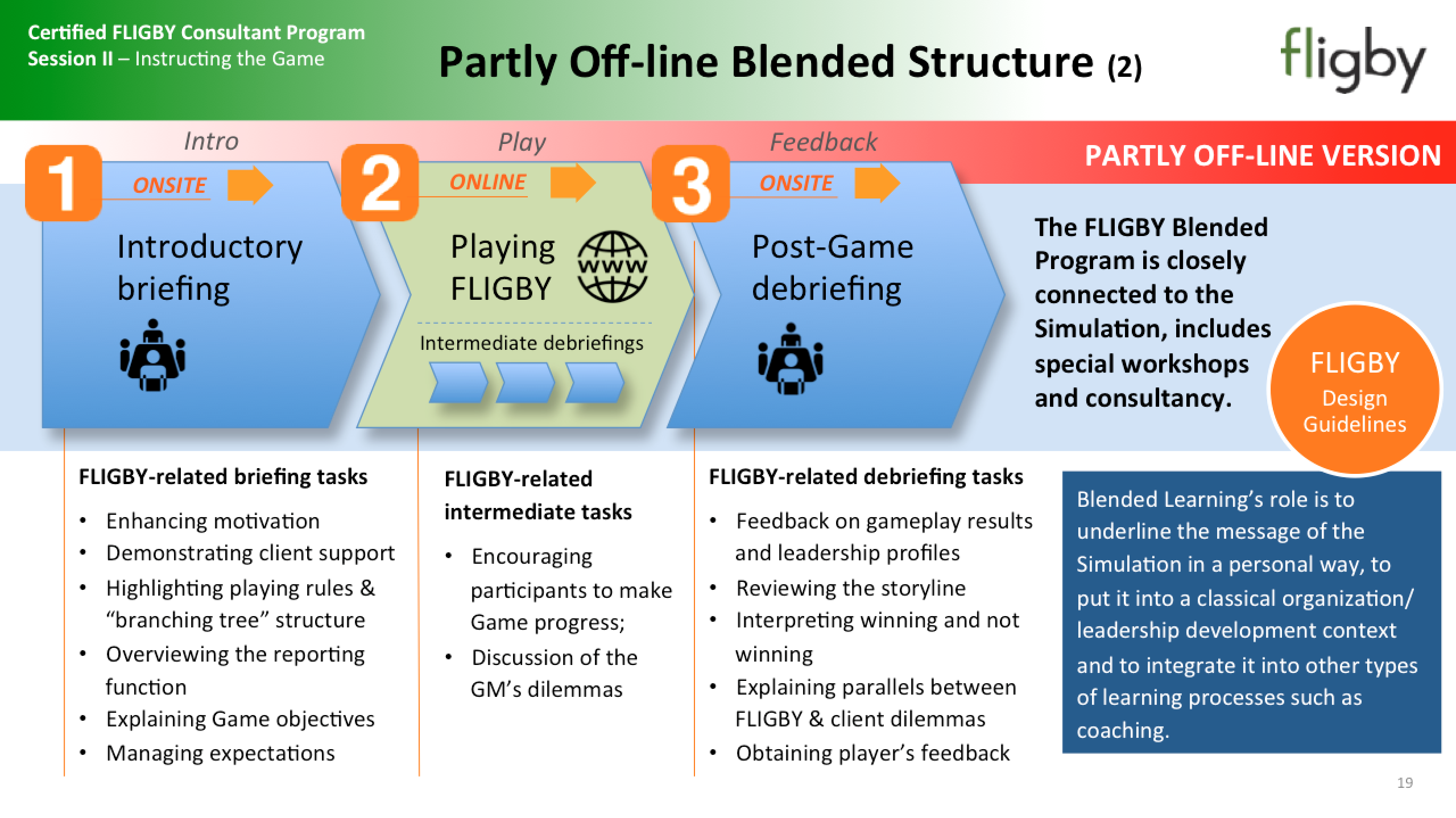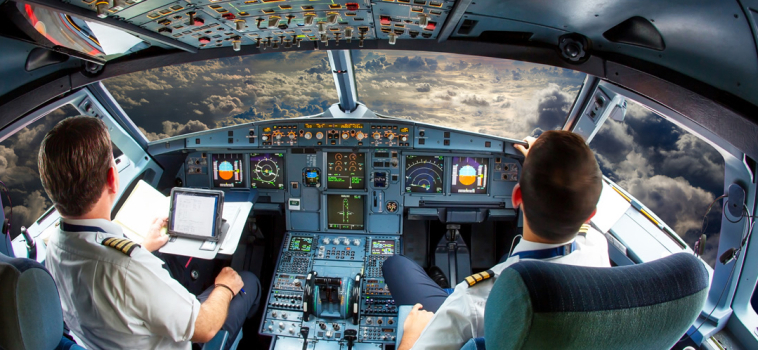How to “Blend” when Experiential Learning Model is Needed
Implementing an experiential learning model with simulation
What percentage of the knowledge you need to do your job is stored in your mind? The answer to that question in 1986 was approximately 75%. Still, in 2008 this number was only 8-10%, according to the study done by Robert Kelley at Carnegie-Mellon University, who surveyed several thousand knowledge workers for 20 years. This implies that 90 percent of the skills used by today’s knowledge workers are experiential.
It also implies that an experiential learning model is crucial to effective leadership development. While “learning by doing” does not have to be a brick-and-mortar, in-person experience and can be done just as effectively in particular virtual environments as exemplified by interactive movie-based business simulations like FLIGBY, it should be combined with some form of collaboration and the involvement of “living” instructors, peers or experts for best results.
This article explains how to optimally blend online learning methodology with life interactions to ensure the experiential learning curve will be most effective.
Definition of the Blended Learning
The classical definition of blended learning defines it as an approach to training and professional leadership development that integrates traditional instructor-led or supervisory interaction methods, generally delivered in person, with a virtual educational program and opportunities for interaction online that include some elements of participants’ control over time, place, path, or pace. “Blended Learning in Action” list the following hallmarks of successfully implemented blended learning:
- personalization and providing unique learning pathways for individuals
- agency and giving learners opportunities to participate in critical decisions
- connectivity and learning collaboratively with peers and experts.
In instances where experiential learning is required, combining these two components of blended learning must be even more of a synergy for the learning model to be effective. The blend of online and offline modalities must balance theory and practice and effectively combine individual and group learning approaches into one cohesive and continuous learning experience. Combining individual experiential learning must be carefully crafted into a blended approach with enough expert support.
The blend of online and offline modalities must balance theory and practice and effectively combine individual and group learning approaches.
On the individual level, effective experiential learning is about extracting learning from every experience, and it requires that participants:
- maintain a bias toward learning in the face of pressure
- engage in tactics that enhance learning
- seek feedback
- regulate emotion to enable learning
- create a support network
- reflect on the experience throughout
- engage in vicarious learning and communities of practice.
According to “The Six Disciplines of Breakthrough Learning,” an experiential learning program should begin with preparation before the action starts and strong follow-up after the action to increase the impact. This three-phase approach of preparation, learning, and follow–up enhances how attention is activated and leads to meaningful development experience.
Experiential Learning Model: Train Your Leaders Like Pilots
Some of the most powerful examples that inform blended-experiential learning come from pilot training. Individual experiential learning using flight simulators is full of a comprehensive and complex digital toolset and is typically combined with instructor-led learning in pilot training programs. One of the most profound benefits of using flight simulation to train pilots is the opportunity to practice handling in-flight emergencies and risky situations without the threat of any actual danger. In a simulated flight, the trainees can make mistakes that may be impossible to survive in the real world.
The real added value of this experiential blended learning process comes in the form of feedback on performance and opportunities for reflection on how practical tasks were solved. One’s performance in the virtual environment of the simulation is evaluated by a highly experienced professional in a one-on-one session and further informed by the game-based assessment of skills as measured during the simulation.
“Most enjoyable activities are not natural; they demand an effort that initially one is reluctant to make. But once the interaction provides feedback to the person’s skills, it usually begins to be intrinsically rewarding.” – Prof. Mihaly Csikszentmihalyi.
Adequate training of leaders of all types can be approached in much the same way as pilot training, as any industry must deal with risky decisions and can benefit from a safe environment for testing and learning from mistakes. Virtual leadership simulation games like FLIGBY provide the same type of opportunities for emerging and seasoned leaders to practice identifying, assessing, and mitigating risks that can help them learn how to avoid dangerous situations in the first place. Simulation is a useful way to practice dealing with emergencies and significant .decisions in a low-stress virtual environment.
What are the benefits of using Simulation in Leadership Development?
Learning by Doing Approach to Leadership Development
Training leaders is very similar to training pilots. Both require experiential learning and can be done in an environment that does not put them at risk of experimenting with living souls. Unfortunately, traditional forms of leadership development often do not support experiential learning. “Learning by doing” requires learning from our mistakes and failures. Leadership is probably the most complex human activity and cannot be learned from books or seminars. Leaders must practice decision-making in unusual, challenging, and demanding situations where they can test and fail more than once until they can acquire all the competencies that make a good leader. Effective leadership is a form of mastery, and shallow approaches to cultivating skills do not work.
The FLIGBY interactive-movie game is a portfolio of people leader experiences rooted in real-world dilemmas that require sophisticated use of managerial competencies, focusing on soft skills. In those simulated experiences, decision points associated with critical assumptions are measured in real-time, and comprehensive player profiles are generated. These reports are then used for debriefing sessions to enhance knowledge retention and translate the lessons learned in the game to real-life problems.
Effective experiential learning components must include experimentation, feedback, and regulation of emotion.
Experimentation encourages the development of learning versus a performance mindset, which is crucial to sustained progress and retention of information over time. In FLIGBY’s simulated reality, players can problem-solve and observe different outcomes in a sequence of leadership decisions; they can adjust course in real-time, and obtain feedback, all without fear of real-world consequences.
“…It is when we act freely, for the sake of the action itself rather than for ulterior motives, that we learn to become more than what we were.” – Prof. Mihaly Csikszentmihalyi
Frequent feedback keeps players engaged and motivated to progress through incredible difficulty and complexity levels. In blended learning, the feedback is further enhanced because it occurs immediately during the game and very close to the learning experience via debriefing of the post-game report, maximizing skills retention. In FLIGBY, feedback is immediate as players see the consequence of their decision to progress toward goals and receive mentor feedback on their decision-making abilities.
Extreme emotion tends to inhibit the learning process when, for example, fear of the consequences of one’s decision is present. For that reason, simulations are a perfect solution for creating a safe environment to experiment with. In addition to a greater sense of psychological safety created by the virtual environment, the immediacy of feedback provided in the game further lessens anxious feelings. It supports emotional regulations because one can adjust the course in real-time. In FLIGBY, players learn to cultivate soft skills as they must regulate their emotions and pay close attention to their teams’ emotional states. In addition to running a profitable and sustainable business, the game’s ultimate goal is to move as many members of one’s team toward the ideal emotional state of true engagement and optimal performance, also known as the state of Flow. (See our article on how mapping flow states can be used as a management tool).
Blended experiential learning occurs through a three-phase approach of preparation, learning, and follow–up.
Based on our experiences of a decade at FLIGBY’s research lab, we have gained a solid understanding of how soft-skills simulations should blend with briefing and debriefing sessions to ensure long-lasting effects. Here, blended experiential learning occurs through a three-phase approach of preparation, learning, and follow–up. In the basic blended structure, the introductory briefing explains the game’s objectives, installation, and rules sets expectations, and gives an overview of the reporting. The intermediate tasks during gameplay, carefully designed to enhance motivation and retention of knowledge, encourage progress through feedback and reflection. Finally, the post-game de-brief allows a deep dive into gameplay results and leadership profiles.
Debriefing of the individual report also allows one to reflect on their performance during the decision-making points. It will enable one to analyze one’s use of specific leadership skills (in this case, 29 Flow-Leadership Skills) to overcome the game’s challenges. The report contains KPIs relevant to the environment, lessons learned, evaluations by a mentor, comparisons to other team members, the company, and the entirety of the FLIGBY database. Still, most importantly, it involves input from experts and further opportunities to reflect on how to apply acquired skills to the player’s reality. Other worthwhile de-briefing tasks can include interpreting winning and not winning and drawing parallels between the storyline and dilemmas players face in their organizations.

Conclusion
Active attention before, during, and after a development experience leads to a significant increase in retention and application of new skills on the job, according to a strategic research study on unlocking the value of on-the-job learning done by the Corporate Board in 2009.
Impactful leadership development requires experiential learning, which can be done in particular virtual environments like interactive movie-based simulations. Still, without the involvement of “living” instructors, the learning curve will not be effective. This experiential, blended learning form could represent the ultimate design model for today’s complex and ever-evolving leadership development needs.
Most importantly, combining the best of both blended and experiential learning worlds, programs like FLIGBY can be quickly and effectively adopted into fully remote leadership development curricula.
References
- Csikszentmihalyi, M. (2004). Good Business: Leadership, Flow, and the Making of Meaning. New York, NY: Penguin.
- Marer, P., Buzady, Z. & Vecsey, Z. (2017). Missing Link Discovered. ALEAS Sims, California (Publisher)
- McCauley, C. D., DeRue, D. S., Yost, P. R., & Taylor, S. (2014). Experience-Driven Leader Development: Models, Tools, Best Practices, and Advice for On-The-Job Development. San Francisco, CA: Wiley.
- Jefferson, A., Wick, C. W., & Pollock, R. V. H. (2006). The Six Disciplines of Breakthrough Learning: How to Turn Training and Development Into Business Results. Hoboken, NJ: John Wiley & Sons. Inc.
- Tucker, C. R., Wycoff, T., & Green, J. T. (2016). Blended Learning in Action: A Practical Guide Toward Sustainable Change





